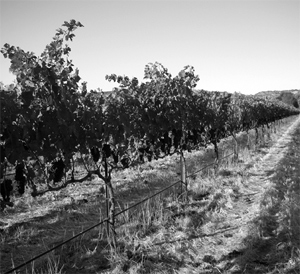2014 Babylon Tenbrink Vineyards

This wine is composed of 100% Petite Sirah from Steve Tenbrink’s remarkable vineyard on the Jones Ranch in Suisun Valley, about 15 miles east of the Carneros of Napa. The valley is warmer than Carneros, but not by much. The soils in most of the surrounding vineyards is very deep and rich alluvium, similar to the middle of Napa Valley— and not great for growing grapes. But this vineyard sits on an ancient river bed: a few feet below the surface of the soil one finds a deep layer of sand, and beneath this, the ancient cobble of the river. For this reason, the vineyard offers growing conditions as if it were rocky and not bottomland. The vines were planted in the 80s and grafted to Petite Sirah in the 90s, and because of the soil, they exhibit perfectly balanced growth, with none of the excess vigor one might expect from the site. On top of this, Steve farms the vineyard organically and without irrigation. It is truly a superb site.
2014 was the third year of intense drought and produced fruit of absolutely optimum ripeness and concentration, without a trace of over-ripeness. The drought has the most remarkable effect on everything to do with ripeness: this wine is very intense and concentrated but very fine. Even though it is dense and very powerful, it is not the least heavy and shows a kind of tannic elegance.
The wine is made from a single row in the vineyard. In 2014, this allowed us to make only one barrel of wine. We used to harvest this vineyard very late; toward the middle of October, but now, during the drought, we harvest in the middle of September. We look for the slightest degree of desiccation in the fruit as it ripens. The tannins are rich and ripe, and the fruit is now beyond the horrible jammy stage, and well into a kind of dried meat savoriness.
The winemaking is typical for our red wines: We bring the fruit in, introduce it gradually into 600 liter puncheons turned vertical, with their heads removed. We stomp the fruit moderately as it goes in, with the effect of breaking about half of the berries but leaving the rest intact and on the stems. Then we leave it alone. In a week or so, fermentation starts and a cap forms. Still we leave it alone. We call this the Courier Protocol— an extended floating cap fermentation with a minimum of punchdowns and no pump-overs. After about 3 weeks of fermentation, we drained the wine away, pressed the remaining pomace very gently, and aged the wines for 36 months in a single neutral 220 liter barrel, without topping or SO2 for the first two years, and only one topping and SO2 addition in its whole life.
We think that the slow constant exposure to oxygen, and simultaneous undisturbed resting on the lees, are essential to the development of the wine. We began this process with an experiment in 2009, and decided that the wine we made with the additional year of aging was not only more sophisticated and more complex— in some ways, it was another, much better wine. The main difference is that tertiary aromas of dried mushrooms and leather replace the piercing dried fruit aromatics of the shorter-aged wine. The wine is bottled with 0 free SO2 and about 30 mg/L total.
A note on the name: when I first started working with this fruit, I was making wine in Napa, and always had many colleagues around. In 2003, the Tenbrinks made their first delivery of fruit for Scholium for me, and brought the grapes to the winery I was then working at in Napa. My friends were astounded that I was bringing grapes from an outside region, and one with absolutely no reputation for quality, into Napa. They reminded me of the Ancient Romans, and the way that they viewed everything outside of the walls of Rome. Everything outside was barbaric, uncivilized. Babylon, as opposed to Rome.
Total production: 24 cases.